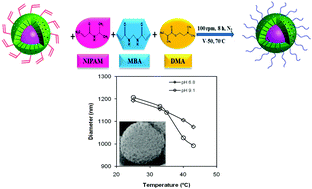Mesoporous magnetic silica particles modified with stimuli-responsive P(NIPAM–DMA) valve for controlled loading and release of biologically active molecules
Abstract
Mesoporous magnetic silica particles bearing a stimuli-responsive polymer valve were prepared and their performance as a microcapsule was evaluated. In this study, first, mesoporous magnetic iron oxide (Fe3O4) particles were prepared by a solvothermal method. Then, the magnetic particles were coated with silica and functionalized with vinyl groups using 3-(trimethoxysilyl)-propyl methacrylate (MPS). Subsequently, the Fe3O4/SiO2 composite particles grafted with MPS were used to carry out the seeded precipitation copolymerization of N-isopropylacrylamide (NIPAM) and 2,2-dimethylaminoethyl methacrylate (DMA). Here N,N′-methylenebisacrylamide (MBA) was used as a cross-linker. Brunauer–Emmett–Teller (BET) surface analysis suggested that the mesoporous structure was retained in the final Fe3O4/SiO2/P(NIPAM–DMA–MBA) composite hydrogel particles. The prepared Fe3O4/SiO2/P(NIPAM–DMA–MBA) composite hydrogel microspheres exhibited a pH-dependent volume phase transition. At lower pH values (<7), the inclusion of DMA shifted the volume phase transition to higher temperature because of the protonation of the tertiary amine groups. The composite hydrogel particles possessed a high saturation magnetization (51 emu g−1) and moved under the influence of an external magnetic field. The loading-release behaviour of these biologically active molecules suggested that a portion of the encapsulated guest molecules was released at a temperature below the lower critical solution temperature, LCST (<35 °C).



 Please wait while we load your content...
Please wait while we load your content...